Background on...
DANCE WITH THE DRAGON
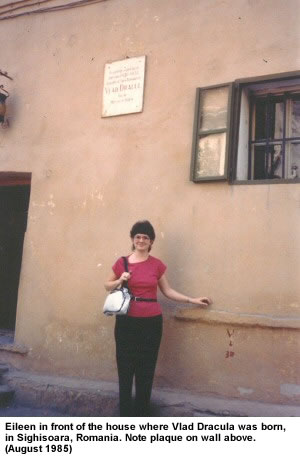 For DANCE WITH THE DRAGON, I drew upon my observations of not only Washington,
D.C., where I often visited relatives, but also of Eastern Europe, where I
traveled in August, 1985. My pre-Glasnost trip went to Austria, Hungary, Romania,
Bulgaria and Yugoslavia. Like most tourists, I visited Bran Castle, which
is touted as “Dracula’s Castle” but where the historical
Vlad Dracula spent only a short period, while in captivity. Tourists are taken
there
chiefly
because it is in good repair — Dracula’s real castle, on the Arges
river, is in ruins and almost inaccessible. I was more intrigued to see Dracula’s
birthplace in Sighisoara, Romania, which at least in 1985 was a perfectly preserved
Medieval town. Vlad Dracula was born in the equivalent of a “townhouse” on
one of the main streets. There’s a plaque on the building outside, and
a bust of him indoors on the first floor. For DANCE WITH THE DRAGON, I drew upon my observations of not only Washington,
D.C., where I often visited relatives, but also of Eastern Europe, where I
traveled in August, 1985. My pre-Glasnost trip went to Austria, Hungary, Romania,
Bulgaria and Yugoslavia. Like most tourists, I visited Bran Castle, which
is touted as “Dracula’s Castle” but where the historical
Vlad Dracula spent only a short period, while in captivity. Tourists are taken
there
chiefly
because it is in good repair — Dracula’s real castle, on the Arges
river, is in ruins and almost inaccessible. I was more intrigued to see Dracula’s
birthplace in Sighisoara, Romania, which at least in 1985 was a perfectly preserved
Medieval town. Vlad Dracula was born in the equivalent of a “townhouse” on
one of the main streets. There’s a plaque on the building outside, and
a bust of him indoors on the first floor.
(For more information check out http://goeasteurope.about.com/cs/romania/a/dracula_castle.htm)
Reading Bram Stoker’s DRACULA all the way through for the first time,
during my freshman year in college, strongly influenced my decision to write
horror. I don’t think it was the first horror novel I’d read — I
know I already was familiar with ROSEMARY’S BABY by Ira Levin — but I’d
never thought much about vampires before, and suddenly I found the theme compelling.
Over the years, though, I’ve been struck by the fact that most interpretations
of DRACULA tend to ignore the character’s military background. Even Stoker
presented him not as a romantic figure, but as a formidable leader of men who
used clever strategy against his enemies. The wealth of information on the
historical Dracula that came to light (ouch!) in the 1970s only reinforced
this image of Vlad as a fearless soldier and Machiavellian diplomat. These
are the traits I hoped to bring out in my homage, DANCE WITH THE DRAGON.
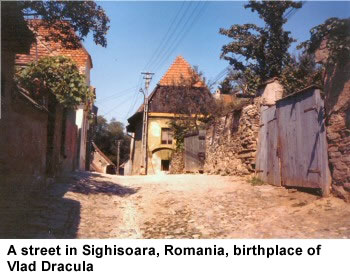

Background on... RIDE A DANCING HORSE
As a girl, I read every horse book in print, but I never wrote a book on this
subject until RIDE A DANCING HORSE. Let me say, right
out of the gate, that I do NOT ride at the same level as the main characters
in RDH! I have ridden dressage for many years, though, and I was motivated
by a desire to do a book involving this sport. I didn’t feel qualified
to write about the politics of high-level, competitive dressage, and preferred
to concentrate on the everyday breeding and training of horses. The idea of
a Spanish-born trainer working with Andalusians added an exotic, glamorous
note, and southern California seemed the most likely setting. These details
also presented obstacles to overcome, because although Andalusians were the
original dressage horses in the royal courts of Europe, and the forerunners
of the famous Lipizzaners, today they have been overshadowed by the bigger “warmblood” breeds.
So the hero, Diego, would face the challenge of persuading potential customers
that his horses could compete successfully in the modern show ring.
 Although I’ve ridden off and on (another pun!) most of
my life, I only had a horse of my own for a couple of years. Brenda, a
chestnut thoroughbred
mare, came into my life in the spring of 1999. I knew little about her history,
but she’d obviously received some dressage training and had a wonderful
temperament for learning more. Unfortunately, she also came with a slight case
of “heaves” or COPD — a sort of horse emphysema — which
rapidly worsened in spite of my best efforts to maintain her health. After
the first year or
so, I realized it was cruel to keep trying to ride or show her, and I retired
her to a wonderful nonprofit facility, Bright Futures Farm, in Spartansburg,
PA. She received the best possible care there, but finally passed away of natural
causes, at only 14, in November, 2003. On her healthier days, Brenda was a
joy to ride, being intelligent and alert, but also gentle and trustworthy.
When I took her into a show ring, I always felt we were a team, on the same
side. Brenda also showed an amazing gift for bonding and even empathizing with
her fellow horses. If there’s anything to reincarnation, she’s
going to come back as one hell of a nice human being! (See a moving tribute
to Brenda, by her last caretaker, at http://www.brightfuturesfarm.org/Remembering%20Old%20Friends.htm.) Although I’ve ridden off and on (another pun!) most of
my life, I only had a horse of my own for a couple of years. Brenda, a
chestnut thoroughbred
mare, came into my life in the spring of 1999. I knew little about her history,
but she’d obviously received some dressage training and had a wonderful
temperament for learning more. Unfortunately, she also came with a slight case
of “heaves” or COPD — a sort of horse emphysema — which
rapidly worsened in spite of my best efforts to maintain her health. After
the first year or
so, I realized it was cruel to keep trying to ride or show her, and I retired
her to a wonderful nonprofit facility, Bright Futures Farm, in Spartansburg,
PA. She received the best possible care there, but finally passed away of natural
causes, at only 14, in November, 2003. On her healthier days, Brenda was a
joy to ride, being intelligent and alert, but also gentle and trustworthy.
When I took her into a show ring, I always felt we were a team, on the same
side. Brenda also showed an amazing gift for bonding and even empathizing with
her fellow horses. If there’s anything to reincarnation, she’s
going to come back as one hell of a nice human being! (See a moving tribute
to Brenda, by her last caretaker, at http://www.brightfuturesfarm.org/Remembering%20Old%20Friends.htm.)
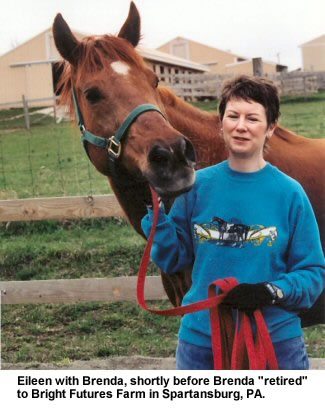

Background on... BLACK FLOWERS
 BLACK
FLOWERS grew out of two influences--my many years driving around New Jersey
covering visual art for The Star-Ledger, and my love for Ira Levin's
novels, especially THE STEPFORD WIVES. BLACK
FLOWERS grew out of two influences--my many years driving around New Jersey
covering visual art for The Star-Ledger, and my love for Ira Levin's
novels, especially THE STEPFORD WIVES.
I spent long hours cruising down highways and passing vast, shiny, corporate
headquarters with mysterious names that gave not hint of what the companies
actually did. Sometimes I'd review art shows in the public galleries of corporate
buildings, and the level of security made it clear that these firms took their
internal secrets very seriously.
Once in a while I interviewed a woman artist in her home, and was struck by
the idea that because she'd married a very successful man she could devote
all her time to her artwork. This made me more than a little jealous, because
I had to find time and energy for my writing after I'd already put in a full
day of work. I'd fantasize about what my life might have been like if I'd married
right after college, and my husband had pursued some highly lucrative career.
I think the seed finally took root one afternoon as I was winding up an interview
with one such woman--who lived in a lavish, modern house in an expensive, wooded
neighborhood--and her husband came home while I was there. I knew he was a
corporate bigwig, and I knew he'd used his influence with my editor to get
me to do a story on his wife. Perhaps because I was aware of this and resented
it a little, he gave me the creeps. I started thinking, "What if a woman
who was creative, intelligent and had a well-developed social conscience found
out something about her husband's business she couldn't accept? What if she'd
been living happily on his high income, and suddenly couldn't bear to do that
anymore? What if she felt driven to investigate further, to know the worst,
and eventually to try to stop him, no matter what the cost?"
I began to put that together with the idea of those mysterious corporate headquarters
I saw along the Jersey highways…and BLACK FLOWERS bloomed!

Background on... PARAGON
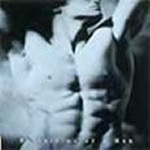 Ever notice how many fables and classic stories deal with a homely, strange
or downright ugly man winning the love of a beautiful woman? Think of CYRANO
DE BERGERAC, BEAUTY AND THE BEAST and THE HUNCHBACK OF NOTRE DAME. And then
we have the numerous stories of men who will settle for nothing less than their "ideal
woman" shaped to their personal specifications, such as PYGMALION and
all of its imitators, right up to the movie PRETTY WOMAN. Ever notice how many fables and classic stories deal with a homely, strange
or downright ugly man winning the love of a beautiful woman? Think of CYRANO
DE BERGERAC, BEAUTY AND THE BEAST and THE HUNCHBACK OF NOTRE DAME. And then
we have the numerous stories of men who will settle for nothing less than their "ideal
woman" shaped to their personal specifications, such as PYGMALION and
all of its imitators, right up to the movie PRETTY WOMAN.
Nobody ever deals with the reverse situation--a less-than-attractive woman
who wins, or even creates, her ideal man. To balance the scales a bit, I wrote
PARAGON.
I also was inspired by a conversation I once overheard, in which a very homely
woman fantasized that if she ever went to Hollywood she’d probably "go
crazy around all those handsome men." It seemed ridiculous, and yet, if
the sexes had been reversed, would we laugh at a nerdy man for daydreaming
about gorgeous starlets? No so much.
I’ve always enjoyed theater, dabbled in acting myself and discovered
I was no good at it, but I’ve always been fascinated by people who were.
I guess I see actors as doing something very similar to what I do, bringing
fictional characters to life and really losing themselves in alternate identities.
PARAGON is all about how deceptive appearances can be. The homely characters,
including protagonist Lu Bauer and theatrical agent Herb Greenbaum, tap into
their deep reserves of passion, loyalty and courage to become truly heroic.
Desma, the decrepit-looking "bag lady," possesses powers no one would
suspect from her frail, old-country appearance. And actor Eric Troy wears the
best disguise of all, for although he looks like a gorgeous but very human
hunk, is reality he's…Nah, I’m gonna make you read the book!
^ go to top

Background on... DANU'S CHILDREN
My mother's family came from northeastern Pennsylvania, so I visited the area as a child and ended up going to college there. Compared to the New York metropolitan area, it always struck me isolated and almost of another time. I heard stories about the coal-mining days and could see how the decline of that industry had left the region depressed--both economically and psychically.
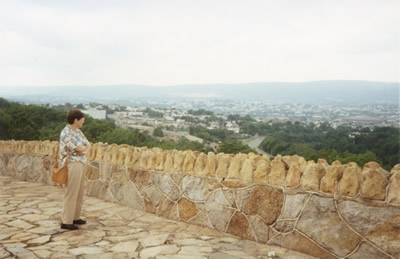
My friend Anne-Marie Cottone, a native of Scranton, Pa., gazes over Lookout Point just outside the city. I gave my fictional town of Carbonville a similar location, which is the setting for a couple of key scenes
During my college years (the 1970s), I absorbed eerie images such as the steaming streets of downtown Scranton and the still-burning "culm dump" that I could see, one year, from my dormitory window. My college friends, all locals and also fans of the macabre, told me about a church that slid downhill at the turn of the century from mine subsidence, and in modern times a convenience store disappeared into a giant sinkhole. These contrasted, in my mind, with the natural beauty of the countryside and mountains. I wanted to write something to capture the mood of the region, but it took many tries over the years before I found the right story line.
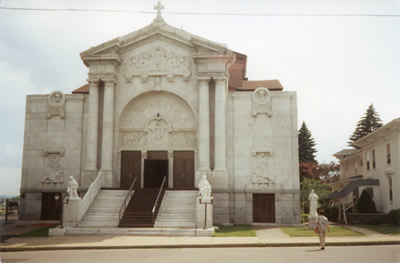
In 1911, St. Ann‘s Basilica in Scranton, Pa., slid downhill because of mine subsidence, far enough to cause serious damage. Eventually, the slide stabilized and the building was repaired. This event inspired a similar scene in DANU’S CHILDREN.
Most of my books feature a fairly innocent female protagonist versus a mysterious male antagonist, but in this book I've flipped that relationship. Here, Kevin O'Leary is the idealistic, highly ethical character and Megan Carey the one who wields a potentially dark power. I borrowed elements of her looks and style, originally, from a certain rock diva with a lot of Heart, and later from a certain TV Warrior Princess--both beautiful brunettes with strong personalities and great charisma.
^ go to top

Background on... ONE BLOOD
The first novel I wrote after I graduated from college was inspired by my love of the paranormal TV soap opera DARK SHADOWS and the other rather romantic vampire tales popular at that time on TV and in the movies. I also was influenced by occasional visits to see my cousin Phil while he was attending Princeton University. I saw Princeton’s gothic, cosmopolitan and intellectual atmosphere as the perfect setting for a different kind of vampire story.
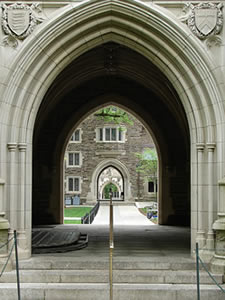 I was tired, though, of seeing worldly, commanding male vampires matched up with innocent and easily manipulated heroines. I wanted to pit mine against a modern, intelligent, strong-willed woman who was almost a match for him...but very sensibly had no desire to become as he was. I was tired, though, of seeing worldly, commanding male vampires matched up with innocent and easily manipulated heroines. I wanted to pit mine against a modern, intelligent, strong-willed woman who was almost a match for him...but very sensibly had no desire to become as he was.
My earlier versions of this story went by the titles NO SUCH THING and BLOOD OF MY BLOOD. I sent them to publishers, but back then “vampire romances”—popular as they seemed on the big and small screens—didn’t “fly” with book editors. After a while, even I decided my tale was a bit corny and predictable, though I still loved the central couple.
I later wrote a sequel, DANCE WITH THE DRAGON, which became more of a thriller. Now a formidable team, my hero and heroine set out to rescue a senator’s daughter from an evil cult leader with vampiric powers of his own. DD came out in 2003, decades after I’d given up on the earlier book. Interestingly, a couple of readers and one critic said they wished they knew more about the hero and heroine and how they’d formed their unusual alliance.
That made me consider reviving the prequel, though I knew it would need a lot of updating. To keep it in sync with DD, I have set it in the late 1990s. Because some new plot points involve remote viewing and terrorism, it also works better to have the action take place before the tragedy of 9/11.
By this time, I had an even firmer grasp on the main characters, now called Kat Van Braam and Jon Sharpay. I knew the issues that would divide them and the feelings that ultimately would bring them together. Still, the romance angle posed a bigger challenge now. I’d made them both so strong-willed that getting them “on the same page” became harder than before!
One last note. It’s clear in ONE BLOOD, even more than in DD, that “Jon Sharpay” and “Elias Van Braam” (Kat’s ancestor) are stand-ins for two very well-known fictional characters by another author. Any true horror fan will recognize this in a minute, and that’s great. On the other hand, the book should still work fine for any reader who doesn’t.
^ go to top

BOOKS | BIO | NEWS | BACKGROUND | ARTICLES| LINKS
|

